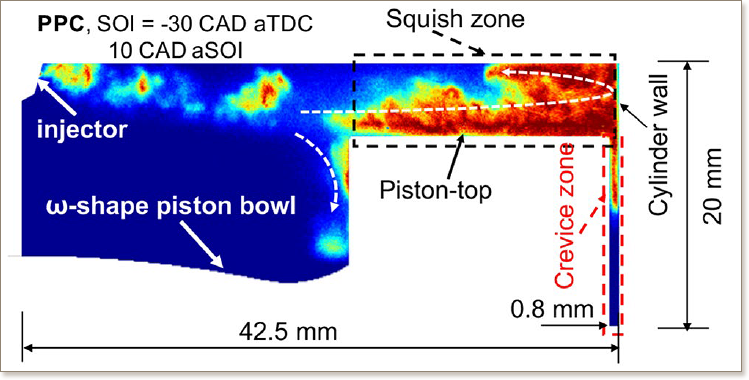Combustion stratification and dynamic flame tracing analysis of partially premixed combustion in a compression ignition engine fueled with low-octane fuel
Y. An, H. Shi, R. Vallinayagam, J. Sim, J. Chang, B. Johansson
SAE Technical Paper, 2019-01-1151, (2019)

Partially premixed combustion (PPC) is a low-temperature combustion concept, which is between conventional diesel compression ignition (CI) and homogeneous charge compression ignition (HCCI). In PPC mode, the start of injection timing (SOI) is earlier than that of CI and later than that of HCCI and stratified in-cylinder fuel/air mixture can be formed to control the auto-ignition by the fuel injection timing. Gasoline fuel is beneficial for PPC mode because of its superior resistance to auto-ignition, which can enhance fuel-air charge mixing process with longer ignition delay time. The scope of this study is to investigate in-cylinder auto-ignition, combustion evolution, combustion stratification, and engine-out emissions at PPC operating mode under lean and low load engine conditions with different injection timings. Primary reference fuel PRF77, was selected as the low-octane test fuel. Fuel-tracer planar laser-induced fluorescence (PLIF) imaging and high-speed color imaging based on natural flame luminosity were performed to visualize fuel injection, spray-wall interaction, and subsequent combustion evolution. Based on the intensity of high sped combustion images, combustion stratification and dynamic flame tracing were evaluated to gain insights into the combustion evolution. Combustion stratification analysis indicated that more inhomogeneous low-temperature combustion was achieved at earlier fuel injection timings along with decreased natural flame luminosity and increased soot emission. Fuel-trapping in piston crevice zone was visualized by fuel-tracer PLIF. Fuel-trapping in squish zone and crevice zone was measured and linked to the formation of unburned hydrocarbon when stronger spray-wall interaction occurs under PPC operating mode. Injector dribbling during the late stage of combustion was found to be as an important source of soot formation through high-speed color imaging and dynamic flame tracing analysis.